Advertisement
These are the good old days for walleye anglers on Lake Erie.
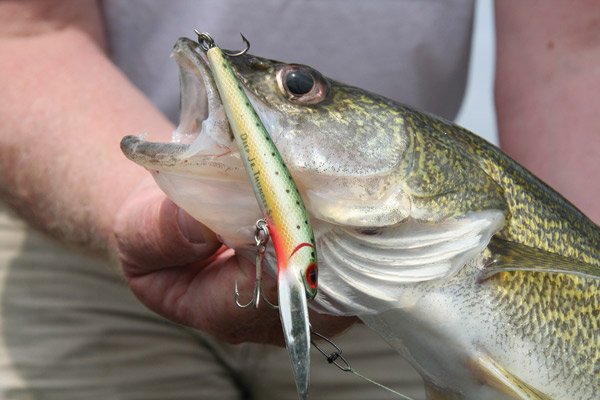
Your best bet for catching a truly trophy Lake Erie walleye is by trolling crankbaits.
Fishing Lake Erie
The bright-yellow, inline planer board wobbled on the surface of the water then began slowly moving behind the boat, signaling a fish. Dave Hoy, a veteran Lake Erie walleye angler from Mansfield, Ohio, jumped up from his seat, grabbed the trolling rod from the rod holder, and began reeling.
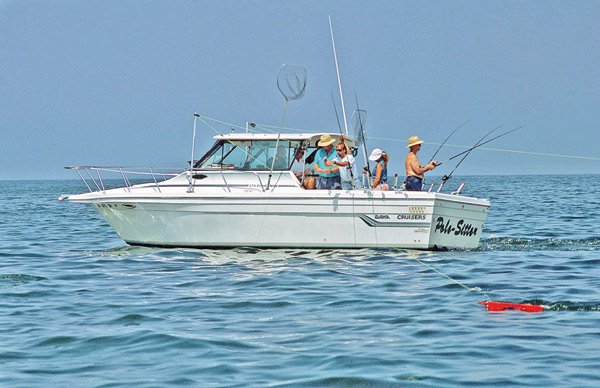
"It fought like a big walleye, but I didn't realize just how large it was," Hoy said. "It wasn't until my buddy netted the fish and laid it in the bottom of the boat that I realized what I had." The walleye weighed a whopping 11.7 pounds, Hoy's heaviest ever.
Trophy walleyes — fish weighing 10 pounds or more — are nothing new to Lake Erie. Long known as the Walleye Capital of the World, Lake Erie has a history of not only producing millions of walleyes annually, but many big fish as well. Some of the most telling big-fish statistics of all time came from the Professional Walleye Trail (PWT) tournament held on the lake in the spring of 2002.
Three consecutive days of perfect April fishing weather, a rarity on Lake Erie, saw 346 post-spawn walleyes in excess of 10 pounds come to the weighing scales. Ted Takasaki of South Dakota set a one-day PWT record of five walleyes that weighed 53.20 pounds. The total-weight PWT record was set by tournament winner Tommy Skarlis of Iowa, 15 fish that tipped the scales at 138.28 pounds. All told, every fifth fish of the tournament was in excess of 10 pounds, and the tournament average for all walleyes weighed was 7.9 pounds!
As incredible as those statistics are, they may pale into insignificance in the near future if predictions by the Ohio Department of Natural Resources, Division of Wildlife, come to fruition. Beginning in 2012 and extending into the foreseeable future, fishery biologists are predicting record numbers of trophy walleyes will be caught from Lake Erie. The main reason is an off-the-charts year-class of fish hatched in 2003 that will begin reaching the 10-pound mark this year. Walleyes can live 20 years or more, and as these fish age they will only grow larger and heavier.
Lookin' for Teenage Girls
"As recently as last fall, we saw some of the lake's 2003 walleyes reaching 28 inches in length with the heavier fish already pushing 10 pounds," said Travis Hartman, a fishery biologist with the Ohio Division of Wildlife at the Sandusky office. "And in addition to the huge 2003 year-class of walleyes, 1993, 1994, 1996, and 1999 were also good spawning years. Those older fish are already of trophy size — 30 inches plus and longer — and will also contribute to the catch of big walleyes on the lake this year."
Hartman went on to say that the largest walleyes in the Lake Erie population are teenage females, those fish between 13 and 18 years of age. "In essence, if you're looking for a trophy walleye, what you're fishing for are teenage girls," joked Hartman. "And surprisingly, the oldest fish in the population may not necessarily be the largest fish. Genetically, most walleyes living to be 20 years old or older are the more slow-growing fish."
Advertisement
Spring
If you've ever wanted to catch a true trophy walleye, your odds are best at Lake Erie in spring, as many of the large fish are concentrated near spawning grounds in the Western Basin. Immediately after ice out is not too early to start. Water temperatures will be in the 30s, literally ice water, but walleyes will still bite. Just make sure your boat and motor are up to snuff and you have all required safety equipment onboard, as capsizing or accidentally going into the water for any other reason at that time of year can be deadly.
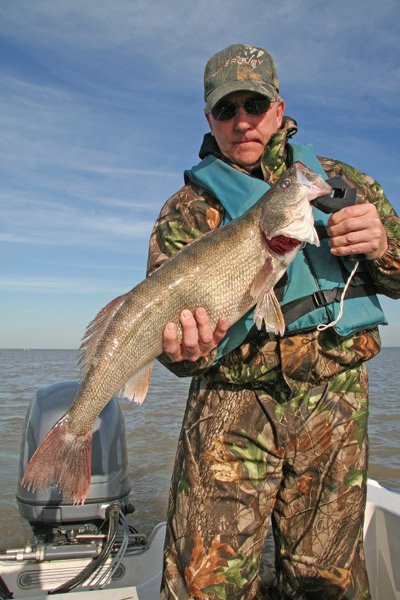
Smaller, male walleyes can be caught relatively easily during early spring by jigging the shallow spawning reefs west of the islands in the Western Basin. Trophy hunters, however, know the larger, female walleyes are caught by trolling just off the reefs in deeper water.
"Many of the big fish caught in the 2002 PWT tournament were caught on Rapala Deep Husky Jerks and other subtle to moderate-action stickbaits slow-trolled 50 feet or so behind inline planer boards," said Keith Kavajecz, a long-time professional walleye angler from Wisconsin. "We were running those baits in about 30 feet of water and they were diving to only about eight feet, so the fish were fairly high in the water column."
A bit of controversy surrounds early-spring walleye fishing on Lake Erie. Some anglers believe the fish should be left alone during the spawn, thinking it will result in higher fish numbers in the future. Others say taking a few walleyes during the spawn makes little difference, biologically, in overall populations.
Fishery biologists support the latter view. For instance, wildlife agencies in the three governmental jurisdictions surrounding the Western Basin (Ohio, Michigan, and Ontario, Canada) all allow Lake Erie walleye fishing year round. Ohio, however, does reduce an angler's daily creel limit from six walleyes to four during the months of March and April.
Summer
As spring turns to summer and the lake water gradually warms, trophy walleyes literally can't take the heat in the shallow Western Basin and head for the deeper, cooler waters of Canada to the north and the Central and Eastern basins to the east. Some of these large fish may migrate 100 miles or more seeking more favorable thermal conditions. And as the fish change locations, so does the way in which anglers fish for them.
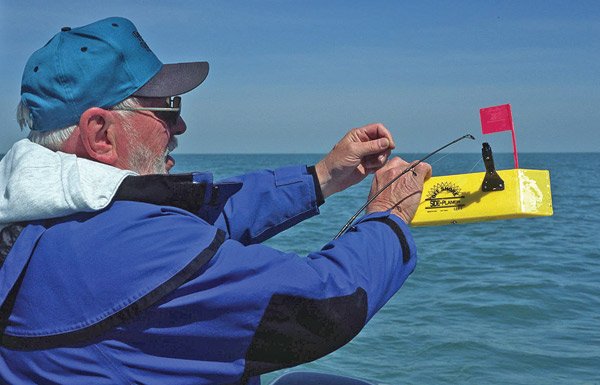
Some fishermen prefer drifting and casting, using either a weight-forward spinner tipped with a whole nightcrawler, or a mayfly rig with just an inch or so of crawler added. These anglers do take some big fish, but by far most of the trophy walleyes come by trolling. The reason is that, if done correctly, trolling keeps a bait in a walleye's strike zone continuously. By contrast, a lure that's cast may only be in a fish's strike zone for a few feet during each retrieve. In addition, trollers cover more water than those who drift and cast. Hour for hour on Lake Erie, trollers top casters hands down at putting fish in the boat; it's simply a more efficient way to fish.
What baits are trollers successfully using during summer? Spoons and crankbaits are the favorite lures when trolling relatively fast, two to three miles per hour. But if walleyes aren't taking "fast food" on a particular day, try slowing down to between one and two mph and pulling nightcrawler harnesses staggered in the water column behind inline weights or drop weights. Using inline planer boards to move lines out to the sides of your boat, rather than trolling directly behind it, is helpful, too.
Fall
Autumn is the second best time of year, following spring, for catching a trophy walleye from Lake Erie. The reason is two-fold: the fish have been feeding all summer, packing on the pounds, and they begin to congregate in large schools close to shore. As the lake water cools, walleyes retrace their migration route from earlier in the year, once again heading toward the spawning grounds of the Western Basin. But this fall movement is very gradual compared to the early-summer migration, almost leisurely, and big fish may linger in a specific area for weeks or even months.
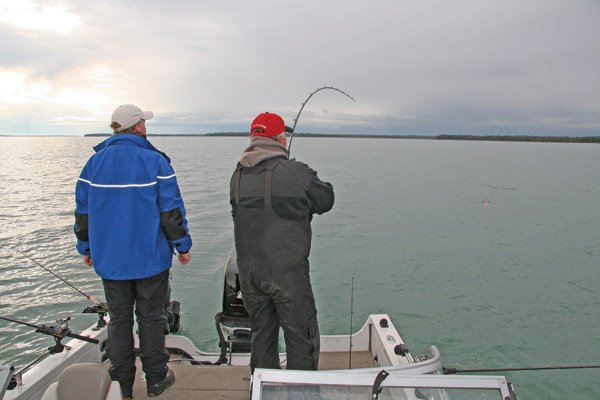
One of these traditional Lake Erie fall fishing hot spots is known locally as "The Bowl," a 15-mile stretch of water near the south shore from Huron, Ohio to Vermilion, Ohio. So named because of its rounded, bowl-like shape on a map, large fish cruise this area in autumn by the thousands, and the fishing can be fantastic for trophy walleyes. Fishery biologist Hartman caught his largest walleye ever from this area, a fish that weighed just over 12.25 pounds.
"I caught it in late fall, November 2010,"; said Hartman. "It hit a Reef Runner I was trolling in the top 10 feet of a 30-foot water column." Reef Runners are crankbaits manufactured locally, just a few miles down the shoreline in Marblehead, Ohio.
As cold weather turns Lake Erie into hard water, trophy walleyes can still be caught through the ice and often are, but fishable ice is never a sure thing. Last winter, for instance, was one of the warmest on record in the upper Midwest and safe ice never formed on the lake. But if conditions are favorable this winter, the first and last ice of the season are usually the most productive, and the best times of day to fish are the first hour or two of daylight and the last hour or two before dark.
If You Had to Choose Just One Lure...
During those three seasons of the year when trolling on Lake Erie is possible — spring, summer, and fall — one type of lure stands out as the most productive for trophy walleyes: crankbaits. "The best way to catch a really big walleye, especially if you’re a novice troller, is to learn how to crankbait fish," said professional walleye angler Keith Kavajecz. "I've probably caught more big fish — 10 pounds plus — using crankbaits than all of my other fishing techniques combined."
This fishing year, 2012, looks to be the vanguard of a long stretch on Lake Erie when chances of catching a truly trophy walleye are better than ever. So if you're a serious walleye guy, or gal, now's the time. As Carly Simon sang in her famous 1971 song titled Anticipation, "... these are the good old days ..."
BoatUS Members save at Boat Shows
Make sure to mark your calendars for two exciting events! BoatUS Members save 25% with code BOAT24US.
